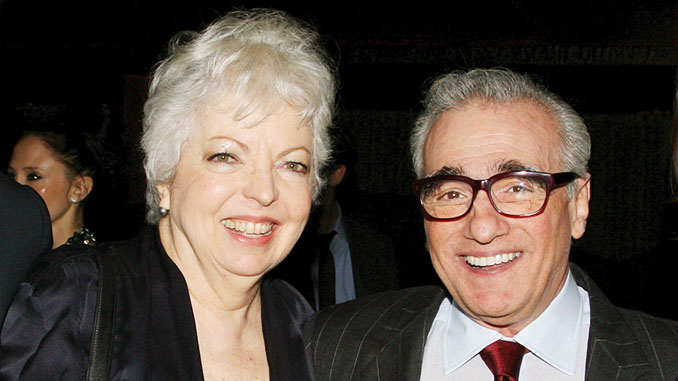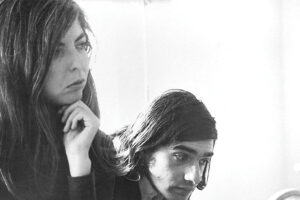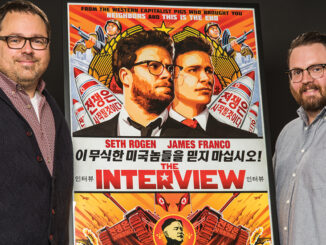
by Patrick Z. McGavin
Who better to edit one of the most acclaimed pictures of the year than one of the most acclaimed editors of her generation?
For “The Irishman,” Thelma Schoonmaker, ACE, once again collaborated with director Martin Scorsese. Together the pair have crafted such unforgettable films as “Raging Bull,” “Goodfellas,” “Casino” and many more.
The new picture stands as their most ambitious work yet. The $160-million project is the most expensive of the director’s career and has already attracted enormous attention for its “de-aging” process that takes decades off the actors’ faces so they can play much younger versions of their characters with minimal or no makeup.
“The Irishman” was made for Netflix, which has already upended conventional Hollywood release patterns by only briefly releasing the movie in theaters before unfurling it on their digital platform.
Adapted from the Charles Brandt book “I Heard You Paint Houses,” the three-and-a-half hour movie examines the life of reputed Philadelphia mob contract killer Frank Sheeran (Robert De Niro). The story pivots on Sheeran’s complicated relationship to two wildly different men, the flamboyant Teamsters President Jimmy Hoffa (Al Pacino) and the taciturn mob boss Russell Bufalino (Joe Pesci).
Schoonmaker – who has been nominated for seven Oscars, and won three – talked with CineMontage about her work process, the de-aging effects, and how “The Irishman” serves as a kind of valediction for Scorsese’s mob movies.
CineMontage: Did Scorsese talk with you conceptually about the editing rhythms he wanted for this film?
Thelma Schoonmaker: Yes. During dailies, which is one of the best times for me, when he is talking about what he wants from the film. Even before, he made it clear it was going to be very simple. There weren’t going to be a lot of flashy things in this movie.
The pace was going to be much different than most movies today. Things like the violence were going to be very brief.

It was going to be more of a character development story than say “Goodfellas” is. That was very interesting for me to realize we were going to be able to pace the film the way it deserved to be paced. Marty had tremendous respect for the audience. He kept saying, “I am not going to explain everything. The audience will figure it out.”
Both you and Scorsese give the impression of being perfectionists. Is there a way you try to remain experimental, or spontaneous, in how you approach your work?
Of course. Always. Even on the set, Marty loves accidents. When something that happens that is either funny or dramatic that nobody expected on the set—it could be an improvisation, it could be something else—he capitalized on that right away. “Are you talking to me?,” from “Taxi Driver” (1976) is a good example. He decided to explore that, and that magnificent scene came out of that.
You never know what is going to happen when you put two pieces of film together. Sometimes an accidental thing will happen and we will be thrilled by it. We are very open to experimentation. He loves that. That is why we did a lot of strange edits in this movie. There are some odd jump cuts. In order to get the best performance, it was worth it to us. It added to the deceptive simplicity of the movie that sucks you in and then hits you in the end.
Obviously there has been a lot of talk about the very complex effects work for Robert DeNiro, Al Pacino, and Joe Pesci. How did that work impact the picture editing?
We could not do the de-aging until we got very close to a fine cut. It was a process that [visual effects supervisor] Pablo Helman at ILM developed very slowly after working with us on “Silence” (2016).
Pablo knew that Marty wanted to make this movie without casting younger actors to play the younger versions of De Niro, Pesci, and Pacino. Marty didn’t think that was going to work.
Pablo developed this system and convinced us with many tests that he did long before shooting started. The big difference was not having a person wear a helmet with two small cameras attached to them by their chin that is all over their faces. There is no way these actors—who are some of the great improvisers in the world—would work that way.
What was great was that Pablo had two 3D infrared lenses on either side of Marty’s lens and those are tracking the actors’ movement. From that point on, Pablo would send us every week a bunch of shots, and we would look at them and ask him to make changes here and there.
Sometimes we found we were losing the performance if too much had been taken out of an actor’s face and we put some of it back in. All in all, it was an excellent process and freed up the actors to just behave the way they normally would.
Sometimes they were wearing a few dots on their face or metal clips on their clothes to track their movements. Actually we screened the film quite a bit with them not de-aged and nobody minded, which was really astounding. I think they were so gripped by the performances. The actors were wearing no makeup at all in the shots they were being de-aged because that would make it too difficult.
Were there some instances with the visual effects, where you had to make editing choices to lessen or downplay the importance of that technology, so it didn’t overwhelm the emotional content of a scene?
Very little. It was mainly [with] Bob. He is such a subtle actor. He is conveying so much with so little. Sometimes with his stuff, we wanted to put a little bit more back in because that is where the acting was. The acting is not only in the eyes. It’s in other facial expressions. In order to retain his great acting and his subtlety, we adjusted there.
Marty had three cameras in the scene where Tony Pro (Stephen Graham) fights with Jimmy Hoffa in Miami. That means you have nine lenses that all need focus-pulling. Marty would have thought out very carefully how he was going to do the scenes where there was camera movement. With improvisation, you can’t do camera movement, or else the editor can’t cut it. All improvisation he did very simply, with the camera locked down.
The movie has a very novelistic structure, with two framing devices: Robert DeNiro’s character Frank reflects back on his life, and the car trip set during the very pivotal moments of 1975. Was that in the script or something you and Scorsese developed?
That was in the script. That was Marty, [writer Steven] Zaillian, a little bit of Nick Pileggi, working out a way to make this trip a sort of spine of the movie.
Frankly I was a little worried about it at first. I wondered if people were going to understand when we cut back to them on this journey, but nobody ever complained about it. Marty and the writers had such a strong conception for it. The interesting thing about it that people will come to see if they watch it over and over, the way they did with “Goodfellas,” they will see the interesting thing about the script is the DeNiro character is unaware the [mob] bosses have decided about the fate of Jimmy Hoffa.
The first is an emotional journey that goes into the recesses of a man’s mind, the second a physical one that allows you to move backwards or sideways in time, and sometimes the points converge.
The whole trip is laying the groundwork for what is going to happen but DeNiro is unaware of it. As people get to know the film better, as they see it again and again … That’s why it was very important for Marty to have that structure.
The way he is being played by both sides is fascinating. The fact they put Jimmy Hoffa’s son [Jesse Plemons] to drive the car and Frank in the backseat. There is this awful moment when Bob nods his head to get in. Jimmy decides to get in the car, and that is the kiss of death. The cinematographer, Rodrigo
Prieto, said Martin Scorsese showed him some films by French director Jean-Pierre Melville before the start of production.
Were there films you looked at for inspiration?
Previously on other movies, Marty has shown me and the crew movies that are major in sequences. For instance, on “The Gangs of New York” (2002), he showed us [Russian director Sergei] Eisenstein, and we cut the opening battle sequence in the snow based on that influence. He often shows me movies that he wants me to be aware of, or that inspired him.
The emotional rhythms of this film compared to the earlier films feels much different. You have confrontations or scenes where actions escalate, but what stands out so much about the film are the quiet moments, with the eerie silences that capture mood and behavior.
The quiet is very important throughout the movie. For example, the way Joe Pesci plays his part. Bosses don’t yell and scream. Maybe there are a few crazy ones who do, but they are so powerful they could just kill you. They are quiet, they are opaque.
The language is never direct: They never say: “You have to kill someone.” They say, “It is what it is.” The whole quiet of the film is a very important thing that Marty wanted and is very different from something like “Goodfellas.”
Scorsese’s films are filled with allusions and references. “Shutter Island” (2010) has a famous one to your late husband, Michael Powell, and his film, “The Red Shoes” (1948). The opening of the new film echoes the start of Sam Fuller’s “Shock Corridor” (1963). Is that serendipitous or planned out?
Marty plans everything very much. He plans an idea for the editing. He doesn’t plan every edit. He thinks like an editor on the set all the time. What is this coming to? That is wonderful for me. That is 50 percent of my work in some ways.
That opening shot was always in Marty’s mind from the beginning. He wanted to slow people down and get them to understand this is not going to be a crash bang opening. That is not the way the movie is going to be and seduce them into a different pace. I kept saying, “Do you feel it’s too long?” No, he would say. I was stunned that he had such courage to know this pace would work when everybody today says, Speed it up.
Could you talk about the use of the Five Satins song, “In the Still of the Night,” as one of the motifs? Did you know he wanted to use that piece beforehand, or was it decided in post?
On some of our films, like “Casino” (1995) or “The Departed” (2006), Marty would try seven different pieces of music against the scene we would cut and eventually one or two would just click, and we’d have a first or second choice out of quite a few options.
For this movie, Marty already decided pretty early on using “In the Still of the Night,” and when I asked him about it, he said: “First of all, it’s the end of this man’s life. Secondly they kill in the night.” That was the reason he wanted to begin and end the movie with that.
Other pieces, he had very strong ideas about many of them. Often we’d audition four or five pieces, and then we moved Robbie Robertson’s score around a lot, depending on how we felt it was working. Marty loves to score his own films. But sometimes there are movies, like “Silence” or “The Age of Innocence” (1993), where you can’t use the music he grew up with.
He has such a genius because he uses music in such a startling way, often against the grain or very much with it. He just has a deep gut instinct about it. He was also trying to evoke the periods.
The movie is certainly an actors’ showcase. How does the editing shape the different performance styles, especially that of Robert De Niro, Al Pacino, and Joe Pesci?
Bob is so generous as an actor. In the scenes with Al, they have a great friendship and they listen to each other. I said to Marty, “Sometimes actors in movies—when you’re cutting, you don’t see it when the edit is finished—but you see the actor is waiting for a cue line. That was not the way with Al and Bob.” They were really listening to each other, and of course, improvising. That was important. We had a feast to pick from.
Do you see this movie as the third part of a trilogy with “Goodfellas” and “Casino,” or is it its own animal in a way?
I don’t see it as a trilogy. I think it’s very different. The violence is very quick. It’s not dwelt on like in “Goodfellas.” It’s there to show what this life is like, what he has chosen to do and then show him alone at the end of his life. It’s Marty’s major statement about the Mafia, which he tried to do before, in “Goodfellas,” but everybody wanted to join the Mafia after “Goodfellas,” because it looked like they were having such a good time.
It’s a very personal film for Marty. All of us who made this movie, except for Rodrigo and the costume person, are very old. When you think about the three major actors, Marty and me, we are older. There’s an incredibly deep sense about the end of life in this movie. ■
Patrick Z. McGavin is a Chicago-based film critic and cultural journalist.
This story appeared in the Q4 2019 print edition of CineMontage.





